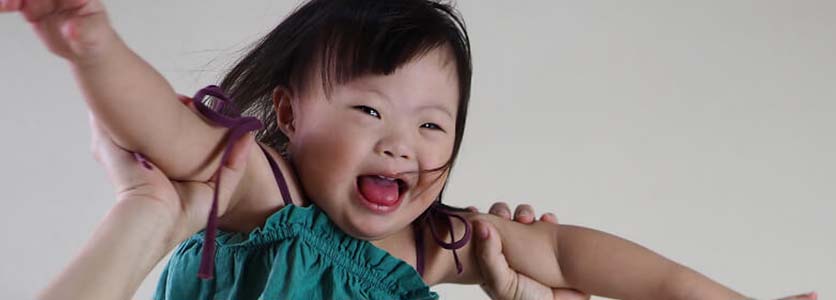One of the many concerns of mummies-to-be is the off-chance of having a Down syndrome baby. It’s an understandable fear that each mother has especially if it’s something that’s in an unknown territory for us.
So, Motherhood Story got in touch to chat with Dr Lee Kok Fung, a Consultant Paediatrician at Columbia Asia Hospital – Seremban, to help us understand better about Down syndrome in kids.
Q1. What is Down syndrome and what causes it?
Down syndrome is by far the most common and best-known chromosomal disorder in humans and the most common cause of intellectual disability. It is primarily caused by trisomy of chromosome 21.
Q2. What are the types of Down syndrome and the percentage that they occur?
There are three types of Down syndrome:
- Trisomy 21
Trisomy 21 means there’s an extra copy of chromosome 21 in every cell. This is the most common form of Down syndrome (95%).
- Mosaicism
Mosaicism occurs when a child is born with an extra chromosome in some but not all of their cells. People with mosaic Down syndrome tend to have fewer symptoms than those with trisomy (21.2%).
- Translocation
In this type of Down syndrome, children have only an extra part of chromosome 21. There are 46 total chromosomes. However, one of them has an extra piece of chromosome 21 attached (3%).
Q3. How is prenatal screening or diagnosis done, and when should a pregnant mother do so?
Screening tests have no risks of miscarriage, but can’t determine with certainty whether a foetus is affected.
There are 3 types of screening tests for Down syndrome: the combined first trimester screening, the non-invasive prenatal testing (NIPT), and the second trimester maternal serum screening.
Combined First Trimester Screening
The combined first trimester screening test is done between 9 weeks and 13 weeks (plus 6 days) into the pregnancy to calculate the chance of a number of abnormalities, including Down syndrome. It is safe for both mother and baby.
A computer is used to combine results from 2 tests: A blood test, done between 9 and 12 weeks into the pregnancy, looks for hormonal changes that can suggest there is a problem with the baby’s chromosomes.
An ultrasound scan, done at 12 to 13 weeks into the pregnancy, measures the thickness of fluid behind the baby’s neck, called the nuchal translucency. This is often larger in babies with Down syndrome. These results, combined with the mother’s age, show the chance of Down syndrome.
Non-invasive Prenatal Test
It involves a simple blood test that analyses DNA from the baby that has passed into the mother’s bloodstream. The test is done after 10 weeks and is more than 99% accurate for Down syndrome.
Second Trimester Screening
Sometimes called a maternal serum screen (MSS) or ‘triple test’, it is done between 14 and 18 weeks into the pregnancy. It is usually offered to women who missed the combined first trimester screening test. It involves a blood test to look for hormones that could indicate the baby has Down syndrome or other diseases such as neural tube defect.

Diagnostic Tests
Diagnostic tests, on the other hand, are extremely accurate at identifying certain abnormalities in the foetus, but carry a small—generally less than 1 percent— risk of miscarriage.
- Chorionic villus sampling (CVS)
A needle, guided by ultrasound, is inserted through the mother’s abdomen to take a sample of cells from the placenta. These are tested for missing, extra or abnormal chromosomes. The procedure is done between 11 and 14 weeks of pregnancy. It is not painful and takes about 20 minutes. The risk of miscarriage is less than 1 in 100.
- Amniocentesis
A needle, guided by ultrasound, is inserted into the mother’s abdomen, to take a sample of amniotic fluid. This is tested for missing, extra or abnormal chromosomes. This procedure is done between 15 and 18 weeks of pregnancy. It is not painful and takes about 20 minutes. The risk of miscarriage is also less than 1 in 100.
- Percutaneous umbilical blood sampling (PUBS, or cordocentesis)
Your doctor will take blood from the umbilical cord and examine it for chromosomal defects. It’s done after the 18th week of pregnancy. It has a higher risk of miscarriage, so it’s performed only if all other tests are uncertain.
Q4. What makes a woman high risk for a Down syndrome baby?

Occurrence is strongly dependent on maternal age. The incidence of this syndrome at various maternal ages is as follows:
- 15-29 years – 1 case in 1500 live births
- 30-34 years – 1 case in 800 live births
- 35-39 years – 1 case in 270 live births
- 40-44 years – 1 case in 100 live births
- Older than 45 years – 1 case in 50 live births
Because of the higher rate of delivery among younger generation, we did see more Down syndrome in young couple.
Q5. How can one prevent Down syndrome during pregnancy?
The risk of miscarriage in subsequent pregnancy:
- One previous miscarriage – risk at 20%
- Two previous miscarriages – risk at 25-30%
- Three previous miscarriages – risk at 40-45%
Q6. What are other health conditions or risks that are associated with Down syndrome?
Down syndrome is generally associated with increased risk of all health conditions, namely cardiovascular system, central nervous system, endocrine system, hematology system.
- A higher risk in congenital heart disease
- A higher risk in central nervous system: spine instability, higher chance of dementia in adulthood
- Endocrine system: congenital hypothyroid, higher chance of diabetes and obesity in adulthood, obstructive sleep apnea
- Hematology: easier to get infection such as ear infection, higher chance to have leukemia
Q7. How will these conditions be tested or detected for?
We will have a checklist to follow during follow up for a child with Down syndrome and will involve multiple discipline team to monitor, from general paediatrician (usually the coordinator), cardiologist, endocrinologist, speech therapist, occupational therapist, etc, according to the patient’s condition. If a red flag is encountered, then further investigation will be carry out.
A Down syndrome child requires life-long monitoring. Once a patient reaches 18 years old, the care will be transferred to the adult physician and family physician.
Q8. In what other ways does down syndrome affect a child’s life?

- Heart defects. About half the children with Down syndrome are born with some type of congenital heart defect.
- Gastrointestinal (GI) defect
- Immune disorders
- Sleep apnea
- Obesity
- Spinal problems
- Leukemia
- Dementia
- Social: Down syndrome children are generally friendly and cheerful. However, the stigma from society may cause pressure to the child and family as well.
Q9. What is the average life expectancy in someone with Down syndrome?
The lifespan for people with Down syndrome has improved dramatically in recent decades. In 1960, a baby born with Down syndrome often didn’t see their 10th birthday. Today, life expectancy for people with Down syndrome has reached an average of 50 to 60 years.
Q10. Do babies with Down syndrome need extra care?

Yes, from prenatal, neonatal, infancy, toddler, childhood, teenager to adulthood, even. People with Down syndrome are living longer and richer lives now more than ever. Though they can often face a unique set of challenges, they can also overcome these obstacles and thrive.
Building a strong support network of experienced professionals and understanding family and friends is crucial for the success of people with Down syndrome and their families.
In Malaysia, there are multiple support groups and NGOs that provide support to the child and family.
This article first appeared in Motherhood.com.my, 5 November 2021
Share:
Was this article helpful?
Share:
Was this article helpful?
Health Packages
Elevate your health with tailored health packages at Columbia Asia Hospital. Take charge of your health journey today.

